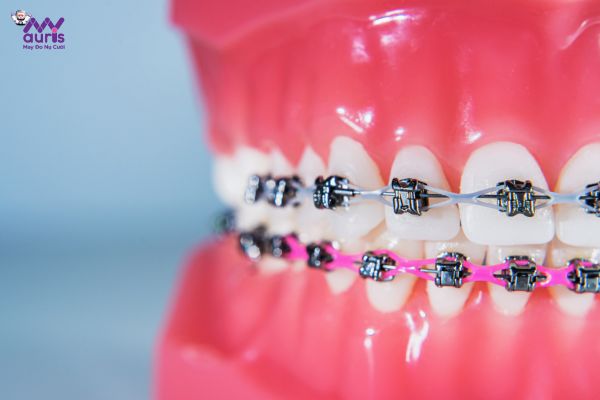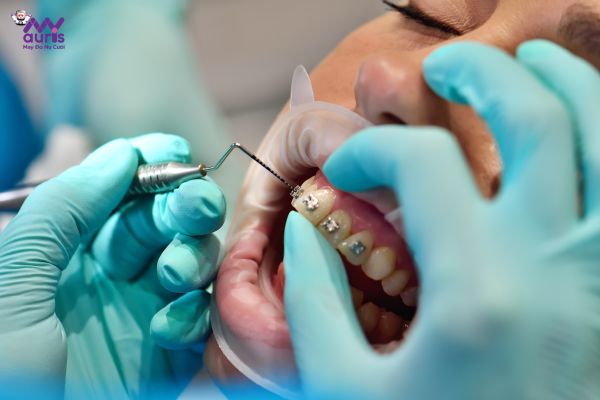Underbite teeth is one of the common malocclusions. This condition not only causes loss of aesthetics but also greatly affects the health and function of teeth. Brackets are a solution chosen by many people to improve this misalignment. To better understand the technique of underbite braces, let’s learn with My Auris dentistry through the following article.
Learn about the condition of underbite teeth
Underbite teeth is a very common form of underbite in dentistry. This condition is easily recognized when observed at home. When the face is at rest, it can be seen that the lower jaw protrudes more, while the upper jaw recedes further inside. At the same time, when observing the tilt angle, you will see that the face is concave, causing loss of harmony for the whole.
Models are divided into 2 types:
- Underbite due to teeth: The jawbone develops normally and is in a stable state, but the upper teeth are misaligned and located in the lower jaw.
- Boneal underbite: underbite means the condition of the lower jaw bone overgrowing compared to the upper jaw bone. From there, manifesting with reverse bite, the upper jaw is inside the lower jaw. This underbite condition is more complicated than dental underbite. Therefore, to accurately determine and diagnose treatment, X-rays must be performed.

There are many causes of underbite teeth, including genetics. For example, families whose grandparents and parents have underbite will have a higher risk of underbite in their children and grandchildren compared to others.
In addition, the cause of underbite also comes from:
- Early tooth loss: early loss of primary molars in the lower jaw without dental implant intervention will cause this part of the jaw to slide forward to chew food, leading to underbite.
- Missing teeth: if the upper front teeth do not grow or grow slowly, it will reduce the length of the dental arch and cause the lower jaw to slide out, causing underbite.
- Loose temporomandibular joint: when the temporomandibular joint is unstable, the lower jaw is easily pushed out and makes the underbite condition more serious.
- Hormonal changes:Pituitary gland dysfunction during the child’s development period can cause misalignment of the jawbone.
- Bad habits: habits such as thumb sucking, tongue thrusting, chin propping, and holding a pacifier for a long time can lead to underbite.
Can you get braces if you have an underbite?
As mentioned, there are two types of underbite: underbite due to teeth and underbite due to jawbone. To determine whether an underbite can be treated with braces, the doctor will find the cause and diagnose the cause of the underbite. If the underbite is caused by teeth, braces can be used to adjust the teeth to the correct position. From there, balance the face, bring aesthetics, and overcome underbite.
However, in cases of underbite due to the jaw bone, braces are not the optimal solution. Because at this time there is no problem with the teeth, but the problem lies in the unbalanced development of the jawbone. Therefore, to overcome this situation, jaw surgery to bring the two jaws into balance will ensure effectiveness.

Can braces remove underbite?
According to dentists, braces are the optimal method to help overcome underbite caused by teeth. Specifically, through the impact and tightening force of the orthodontic appliance, the teeth are pulled into the desired position, correcting bite errors. From there, it helps the teeth to be arranged evenly and neatly, making the smile more confident.
For mild and moderate underbite, the effect is faster, saving orthodontic time. On the contrary, severe underbites and misalignments require a longer period of braces and orthodontics.

In addition, underbite-removing braces no longer depends on the care regime and compliance with wearing the retainer according to the doctor’s instructions after braces. In particular, to get rid of underbite with braces, people must have orthodontics done at reputable, quality dental facilities, ensuring the doctor’s skills to adjust teeth to bring comprehensive results.
Braces are goneDoes underbite need tooth extraction?
Normally, when braces bring comprehensive results, teeth are evenly spaced and beautiful, tooth extraction is advised. Therefore, many people with underbite wonder if they will have to have their teeth extracted.
In fact, whether underbite braces require tooth extraction or not depends on each person’s condition. If the jaw expansion creates more space for the teeth to move and spread evenly, there is no need to extract the teeth. On the contrary, if the jaw is too small, has many misalignments, or crowded teeth that do not have enough room to move, teeth will need to be extracted to increase orthodontic effectiveness.

However, people do not need to worry too much because the doctor will choose teeth that do not take on the main chewing function and do not lose aesthetics. Normally, teeth number 4, 5 and wisdom tooth number 8 are assigned to be removed when getting braces.
Nowadays, with developed technology and techniques, tooth extraction will no longer be an obsession because it reduces pain and the process goes smoothly and gently. After tooth extraction, people just need to follow hygiene, diet and care according to the doctor’s instructions and it will not cause any effects.
When the wound at the tooth extraction site heals, the doctor will proceed with the braces and orthodontic process. After braces are finished, the teeth are spread out evenly, covering the gap, so people do not need to worry about jaw bone loss or gaps in the jaw causing loss of aesthetics.
How long does it take to get rid of underbite?
When choosing orthodontics to correct underbite and malocclusion, most customers want quick results. So how long does it take to get braces off?
Depending on the degree of underbite of the teeth, the bracing method, the doctor’s technique and each person’s constitution, the time to brace underbite varies. Specifically, with mild underbite, using metal braces will shorten the orthodontic time compared to severe misalignment. Normally, the average time for underbite braces for adults lasts 2-3 years.
However, for children, braces will be faster than for adults, especially at the age of 6-12 years old. Because at this time, a child’s jaw bone is still soft and easier to adjust than an adult’s.

Hopefully the information in the article about underbite braces will help people better understand this condition. From there, consider your condition and choose the appropriate dentistry and orthodontic method. Please contact My Auris dentistry immediately for advice and make an appointment as soon as possible.
Anh Thy





